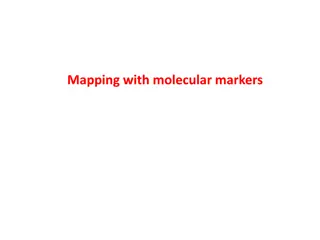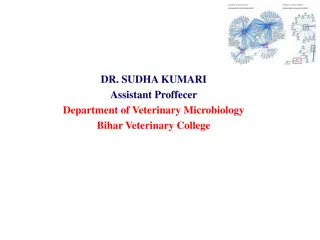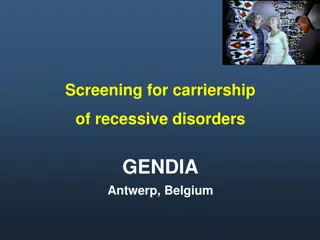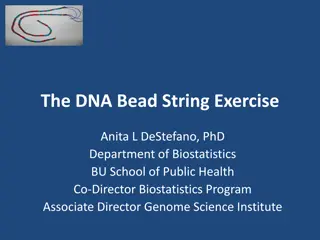Understanding Human Genetic Variation and Its Implications
These slides explore the connection between genetic variations and phenotypes, focusing on how the human genome varies between individuals, identifying associations with phenotypes/diseases, and the impact of sequencing technologies on reading the genome. The evolution of projects like HapMap and the 1000 Genomes project is discussed in detail, along with the distinction between gametic and somatic mutations.
Download Presentation

Please find below an Image/Link to download the presentation.
The content on the website is provided AS IS for your information and personal use only. It may not be sold, licensed, or shared on other websites without obtaining consent from the author. Download presentation by click this link. If you encounter any issues during the download, it is possible that the publisher has removed the file from their server.
E N D
Presentation Transcript
Linking Genetic Variation to Phenotypes BMI/CS 776 www.biostat.wisc.edu/bmi776/ Spring 2020 Daifeng Wang daifeng.wang@wisc.edu These slides, excluding third-party material, are licensed under CC BY-NC 4.0 by Mark Craven, Colin Dewey, Anthony Gitter and Daifeng Wang
Outline How does the genome vary between individuals? How do we identify associations between genetic variations and simple phenotypes/diseases? How do we identify associations between genetic variations and complex phenotypes/diseases? 2
How to read sentences/genes for understanding book/genome? Book Genome Chapters Chromosomes Sentences Genes Words Elements Letters Bases On most days, I enter the Capitol through the basement. A small subway train carries me from the Hart Building, where Key words Coding elements (Exon, 2%) - Become proteins carrying out functions Non-coding elements (98%) Non-key words Gene 1 Gene 2 https://goo.gl/images/vMaz4T
Low sequencing cost enables reading our whole genome 4
Whole Exome Sequencing (WES) reads 2% coding elements of human genome 5
Whole Genome Sequencing (WGS) reads 100%! DNA Coding elements http://www.genomesop.com/somatic-mutations/ 6
Understanding Human Genetic Variation The human genome was determined by sequencing DNA from a small number of individuals (2001) The HapMap project (initiated in 2002) looked at polymorphisms in 270 individuals (Affymetrix GeneChip) The 1000 Genomes project (initiated in 2008) sequenced the genomes of 2500 individuals from diverse populations 23andMe genotyped its 1 millionth customer in 2015 Genomics England sequenced 100k whole genomes and linked with medical records (Dec 2018) 7
Gametic vs. Somatic Mutations https://www.pathwayz.org/Tree/Plain/GAMETIC+VS.+SOMATIC+MUTATIONS 8
Classes of Variants Single Nucleotide Polymorphisms (SNPs) Indels (insertions/deletions) Structural variants Formal definitions: https://www.snpedia.com/index.php/Glossary 9
Single Nucleotide Polymorphisms (SNPs) One nucleotide changes Variation occurs with some minimal frequency in a population Pronounced snip www.mdpi.com 10
After reading our genomes, we find differences: DNA mutations (i.e., genomic variants) Single Nucleotide Polymorphisms (SNPs) normally happen ~1% on individual human genome. Most SNPs are harmless but some matter 11
Insertions and Deletions Black box: DNA template strand White box: newly replicated DNA Insertion: slippage inserts extra nucleotides Deletion: slippage excludes template nucleotides Forster et al. Proc. R. Soc. B 2015 12
Structural Variants Copy number variants (CNVs) Gain or loss of large genomic regions, even entire chromosomes Inversions DNA subsequence is reversed Translocations DNA subsequence is moved to a different chromosome 13
Recombination Errors Lead to Copy Number Variants (CNVs) 15
1000 Genomes Project Project goal: produce a catalog of human variation down to variants that occur at >= 1% frequency over the genome 16
Understanding Associations Between Genetic Variation and Disease Genome-wide association study (GWAS) Gather some population of individuals Genotype each individual at polymorphic markers (usually SNPs) Test association between state at marker and some variable of interest (say disease) Adjust for multiple comparisons Phenotypes: observable traits 18
Example: Genome-Wide Association Study (GWAS) identifies disease associated genetic variants 36,989 schizophrenia cases and 113,075 controls in Psychiatric Genomics Consortium Associated SNPs P=5*10-8 19 Schizophrenia Working Group of the Psychiatric Genomics Consortium, Nature (2014)
p = E-5 p = E-3 20
Morning Person GWAS P = 5.0 10 8 Hu et al. Nature Communications 2016 22
Understanding Associations Between Genetic Variation and Disease International Cancer Genome Consortium Includes NIH s The Cancer Genome Atlas Sequencing DNA from 500 tumor samples for each of 50 different cancers Goal is to distinguish drivers (mutations that cause and accelerate cancers) from passengers (mutations that are byproducts of cancer s growth) 23
Understanding Associations Between Genetic Variation and Complex Phenotypes Quantitative trait loci (QTL) mapping Gather some population of individuals Genotype each individual at polymorphic markers Map quantitative trait(s) of interest to chromosomal locations that seem to explain variation in trait 26
QTL Mapping Example QTL mapping of mouse blood pressure, heart rate [Sugiyama et al., Broman et al.] Logarithm of Odds P(q|QTL at m) P(q|no QTL at m) LOD(q)= log10 quantitative trait position in the genome 28
QTL Example: Genotype-Tissue Expression Project (GTEx) Expression QTL (eQTL): traits are expression levels of various genes Map genotype to gene expression in different human tissues 29
QTL Example: GTEx https://www.genome.gov/27543767/ 30
GWAS Versus QTL Both associate genotype with phenotype GWAS pertains to discrete phenotypes For example, disease status is binary QTL pertains to quantitative (continuous) phenotypes Height Gene expression Splicing events Metabolite abundance 31
Determining Association is Not Enough A simple case: CFTR (Cystic Fibrosis Transmembrane Conductance Regulator) 32
Many Measured SNPs Not in Coding Regions Genes encoding CD40 and CD40L with relative positions of the SNPs studied Chadha et al. Eur J Hum Genet 2005 33
Non-coding variants Non-coding Disease Health 34
Computational Problems Assembly and alignment of thousands of genomes Detecting large structural variants Data structures to capture extensive variation Identifying functional roles of markers of interest (which genes/pathways does a mutation affect and how?) Identifying interactions in multi-allelic diseases (which combinations of mutations lead to a disease state?) Identifying genetic/environmental interactions that lead to disease Inferring network models that exploit all sources of evidence: genotype, expression, metabolic, etc. 35























